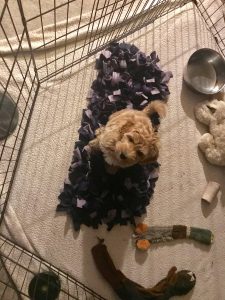BY FRAN JEWELL

I have an 8-week-old puppy visiting me for a couple of weeks. He is as cute as can be, but what is very apparent is that he has learned to demand bark for attention.
I am teaching him about exercise pens and crate training, which I think is imperative for little puppies, but he has been used to getting attention whenever he wants it, probably from his mother!
Not all mother dogs are like that. My mother dog will ignore the demanding behavior from her puppies once they reach about five weeks old. It’s just different mothering styles of different dogs. Some mothering styles, such as permissiveness, can highly influence a puppy’s beginning, sometimes for the good and sometimes for the not so good.
Yes, there is a certain amount of a young puppy moving away from his litter and trying to deal with the separation. But, in this particular case, this puppy is demand barking, saying to me, “I WANT THIS, NOW!”
How do I know that? It’s all about the context and the sound. He demands a treat when he sits. It’s the same bark when he is inside the exercise pen and he is watching me from across the room. He barks as if to say, “Pay attention, NOW!”
The key here is to teach him to be able to soothe himself and be able to play with himself without someone doing it for him—dog or person.
It is excellent for puppies to spend alone time and be happy doing so. This helps to prevent separation anxiety further down the road. If I respond to his barking, even by looking at him, I reinforce what he wants, which is attention. This particular puppy is not fearful or afraid of being alone; he is demanding he not be alone.
To teach him to do this, I must first ensure his food motivation. This particular puppy was free fed by the breeder, so he doesn’t have much interest in working for food from food-dispensing toys. I think food-dispensing toys are important for him because they teach him to problem solve and it uses enormous mental and physical energy so he will sleep better and accept confinement better. Certain kinds of confinement and regular meals are imperative for house training.
In order to increase his interest in food, I have started feeding him regular meals in the food-dispensing toys. If he is not interested in the toy, he soon will be. I pick it up and give it to him a little later.
To encourage self-soothing, I also need to be sure he has plenty of long-term chewing treats. What I mean by that are things like curly bulky sticks, or other hard-chewing toys that take a long time for him to accomplish. Again, food motivation is the key to making this successful.
I also must ignore all barking and crying. It is not our human nature to do this, so I know how hard it is. But, during those first few weeks, I am imprinting behaviors I want. If I don’t want him to be a demand or reactive barker the rest of his life, I have to stop it now. I must let him know that barking gets him nothing. Quiet gets him the things he wants.
Exercise is the next critical component to self-soothing. In most cases, we tend to overexercise puppies when they are young. I use short bursts of walks in my backyard over small obstacles like larger old branches he must go over or under. This nurtures his self-confidence and problem-solving, too! We go around other large obstacles, as well.
The key to a well-adjusted puppy is to start out teaching him he can be by himself and be happy. In the long run, this helps a puppy to develop confidence and appreciate the time with you even more. It also establishes a strong leadership between you and your pup that will bring you years of fewer behavior problems!
Fran Jewell is an Idaho Press Club award-winning columnist, IAABC-certified dog behavior consultant, NADOI-certified instructor #1096 and the owner of Positive Puppy Dog Training, LLC, in Sun Valley. For more information, visit positivepuppy.com or call (208) 578-1565.


